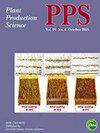Effects of arbuscular mycorrhizal fungi inoculation on infection and growth of rice and pearl millet in upland fields with three water regimes
IF 1.3
3区 农林科学
Q2 AGRONOMY
引用次数: 0
Abstract
Inoculation with arbuscular mycorrhizal fungi (AMF) may enhance crop growth in upland fields, depending on the water regime. To quantify changes in AMF infection rate and subsequent effects on nutrient uptake and growth, we grew rice (wetland crop) and pearl millet (dryland crop) genotypes with or without the commercial inoculant Dr. Kinkon (Glomus sp. R10) in Andosol upland fields in 2020 and 2021. Root infection rates were measured in shallow (0–10 cm) and deep (20–30 cm) layers under three water regimes: well-irrigated, half-irrigated, and non-irrigated. Inoculation enhanced shoot dry weight (SDW), plant height, tiller number, phosphorus (P) uptake, leaf water potential, photosynthetic rate (measured only in 2021) and root transversal area. The increase in SDW with inoculation was higher under well-irrigated than under water-limited conditions. The increment in pearl millet SDW was related to higher P uptake associated with higher infection rates, whereas that in rice SDW was related to maintenance of leaf water potential, greater root transversal area and root length density, and higher P uptake but not to infection rate parameters. Inoculation increased mycorrhizal and vesicular infection rates with the similar tendency for arbuscular infection rate and qPCR. Infection rates were similar across water regimes in both years despite significant differences in plant growth parameters with higher rates in deep than shallow layers. AMF inoculation enhanced infection rates, mostly independent of water regime, but plant growth enhancement was greater under the well-irrigated treatment and was more directly linked with infection rates in pearl millet.接种丛枝菌根真菌对旱地水稻和珍珠粟侵染及生长的影响
接种丛枝菌根真菌(AMF)可以促进旱地作物生长,这取决于水分状况。为了量化AMF感染率的变化及其对养分吸收和生长的后续影响,我们于2020年和2021年在Andosol旱地种植水稻(湿地作物)和珍珠粟(旱地作物),分别使用或不使用商业接种剂Dr. Kinkon (Glomus sp. R10)。在三种灌溉方式下,分别在浅层(0-10 cm)和深层(20-30 cm)测量根系侵染率:充分灌溉、半灌溉和不灌溉。接种提高了茎部干重(SDW)、株高、分蘖数、磷(P)吸收、叶片水势、光合速率(仅在2021年测量)和根横截面积。灌水条件下SDW随接种的增加高于限水条件下。珍珠粟SDW的增加与较高的磷素吸收量和较高的侵染率有关,而水稻SDW的增加与叶片水势的维持、较大的根横截面积和根长密度以及较高的磷素吸收量有关,但与侵染率参数无关。接种菌根菌和水疱侵染率增加,菌根侵染率和qPCR侵染率趋势相似。尽管植物生长参数存在显著差异,但两年中不同水域的感染率相似,深层的感染率高于浅层。AMF接种提高了侵染率,且侵染率与水分状况无关,但灌水处理对植株生长的促进作用更大,且与侵染率有更直接的关系。
本文章由计算机程序翻译,如有差异,请以英文原文为准。
求助全文
约1分钟内获得全文
求助全文
来源期刊

Plant Production Science
农林科学-农艺学
CiteScore
5.10
自引率
4.00%
发文量
27
审稿时长
>36 weeks
期刊介绍:
Plant Production Science publishes original research reports on field crops and resource plants, their production and related subjects, covering a wide range of sciences; physiology, biotechnology, morphology, ecology, cropping system, production technology and post harvest management. Studies on plant production with special attention to resource management and the environment are also welcome. Field surveys on cropping or farming system are also accepted. Articles with a background in other research areas such as soil science, meteorology, biometry, product process and plant protection will be accepted as long as they are significantly related to plant production.
 求助内容:
求助内容: 应助结果提醒方式:
应助结果提醒方式:


